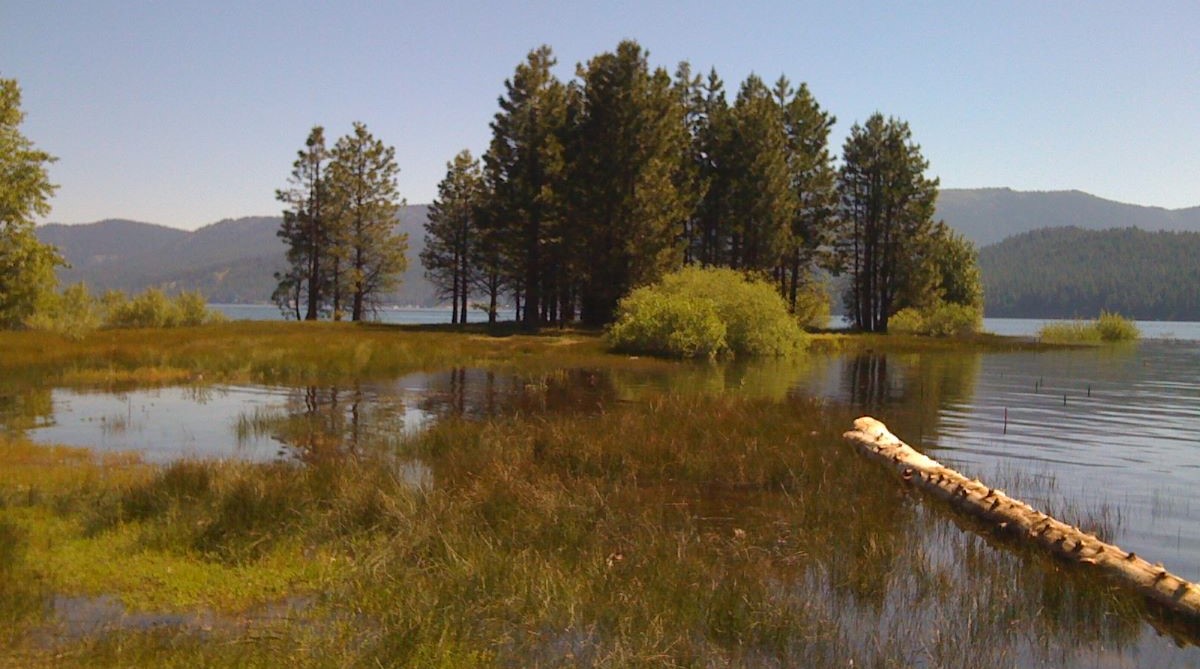In California water news this weekend …
California Drought: The reason why reservoir levels are kept low
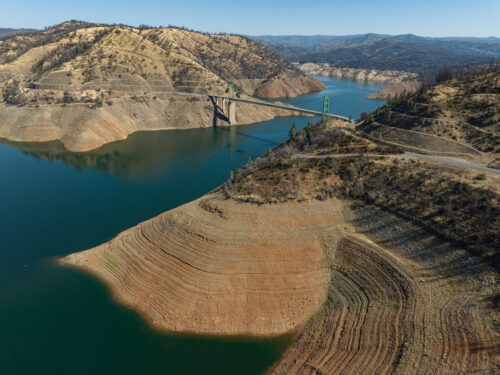
“Another dry week is ahead for northern California, but a pattern shift could be on the way in the coming weeks. October is usually when California gets its first good soaking of the year, or a complete deluge as was the case last year when Sacramento broke its all time daily rainfall record. Sacramento usually averages 0.85 inches of rain in October. As dry weather persists, so does the drought. While there were no changes to this week’s edition of the drought monitor, exceptional drought conditions still blanket most of the San Joaquin Valley and extreme drought covers just under half of the parched state. … ” Read more from Channel 10 here: The reason why reservoir levels are kept low
Some San Joaquin Valley towns pay hefty price to keep taps flowing
“California’s crippling three-year drought is revealing the unique water vulnerabilities of small towns across the San Joaquin Valley. And while the state has stepped in to help impoverished communities and residents whose wells have gone dry due to plummeting groundwater levels, the handful of towns on the valley’s west side that rely on surface supplies are largely on their own. Towns like Huron, Avenal, Coalinga and others may have to dig deep into their limited budgets to buy water at staggeringly high prices – in one case nearly 1,300% above the normal price. The problem for these west valley towns is that they rely entirely on supplies from the federal Central Valley Project (CVP), which transports water in a 400-mile-long network of canals. … ” Read more from SJV Water here: Some San Joaquin Valley towns pay hefty price to keep taps flowing
La Nina firms up winter reservation in the Northwest
“The La Nina that has influenced the climate for the past two winters looks more likely than ever to stay around for a rare three-peat, federal forecasters predicted Thursday. La Nina has a 75% chance of reigning through February, according to the National Weather Service’s Climate Prediction Center. A month ago, the center rated the odds at 54%. Sea-surface temperatures along the equator already were below normal and cooled some more this month, according to the climate center. Cool seas trigger La Nina. Predicting when temperatures will increase to normal is hard, so it’s uncertain how long the La Nina will last, forecasters cautioned. Most climate models favor neutral temperatures by March. … ” Read more from the Capital Press here: La Nina firms up winter reservation in the Northwest
A Delta Legacy: Zuckerman Family Farms
“Over 100 years ago, Chicago native Roscoe Zuckerman first saw the labyrinthine waterways and windswept fields of the California Delta. He was there on a sourcing assignment for his cousin Edward Weyl, who ran a produce company in Los Angeles. But as he got to know the still-wild place and the people cultivating it, he realized he didn’t want to be a middleman tethered to the city. He wanted to be a farmer. “Farming is very, very up and down, so it’s been a roller coaster ride,” says Ed Zuckerman, president of Zuckerman Family Farms and Roscoe’s grandson, of the century that followed. Roscoe and his brothers Morris and Herbert, who also worked at the produce company, convinced Weyl to help them start a farm. They planted their first fields of potatoes, asparagus, celery and other crops on McDonald Island, a slough-bound chunk of Delta land that still forms the heart of the Zuckerman empire. … ” Read more from Comstock’s Magazine here: A Delta Legacy: Zuckerman Family Farms
Desalination plants: can they save California cities?
“In Coalinga, a city in the center of California in the Central Valley, water is as precious as gold: rare, high in value and limited. Water is so limited that the residents could lose access to water entirely in the next two months. The problem is not just Coalinga’s. The whole state of California is in the midst of its worst drought in 1,200 years, a drought which has continued for decades. Now California cities are running out of water. As other cities in California face similar threats, California regulators approved the construction of a desalination plant on Thursday, designed to convert seawater into drinking water and hopefully ease the water crisis plaguing the state. However, controversy shrouds the decision, with environmentalists disapproving of the desalination plant while others believe it is a solution. ... ” Read more from Impakter here: Desalination plants: can they save California cities?
Key facility’s fuzzy future
“There are 14 marine laboratories in California. Just one of them is on San Francisco Bay: the Estuary and Ocean Science Center (EOS), on the rugged eastern shore of the Tiburon Peninsula in Marin County. EOS has trained generations of leading figures in estuary science and management. It possesses a site and facilities that no possible alternative could match. The research community swears by it. And in two years it might close. In the 1970s, after decades as a U.S. Navy property, the 53-acre parcel was considered for inclusion in the Golden Gate National Recreation Area. Instead, in 1977, it passed—for one dollar—to San Francisco State University (SFSU). But the bargain has devolved into a burden, and today a budget crisis threatens to shut the Center down. Even a land sale, for considerably more than one dollar, is among the options the school is considering. … ” Read more from Estuary News here: Key facility’s fuzzy future
California Fish and Game Commission holds hybrid meeting
“At its October meeting the California Fish and Game Commission acted on several issues affecting California’s natural resources. The following are just a few items of interest from this week’s meeting held in Kings Beach, Lake Tahoe with an option for the public to join via Zoom. Newly appointed Commissioner Anthony Williams(opens in new tab) rejoined the dais at this Commission meeting. Williams served as commissioner from 2015 to 2019. Regarding whether to list western Joshua tree as threatened under the California Endangered Species Act (CESA), after extensive deliberation the Commission continued the agenda item to its February 2023 meeting, keeping the public record open for the specific purpose of continued input from tribal governments. … ” Read more from the Department of Fish and Wildlife here: California Fish and Game Commission holds hybrid meeting
Soil survey reveals surprising information on the severity of the Mosquito Fire
“The Mosquito Fire has been well-controlled in Placer and El Dorado counties for several weeks after forcing thousands of people to evacuate. The containment has allowed soil experts to conduct a soil burn severity survey throughout the burn scar. These surveys are completed following a fire to determine the status of the affected watersheds and how long it may take for the native ecosystem to return to pre-fire conditions. Information from these surveys is also used by water managers and other agencies to anticipate needs regarding water quality as well as risks for flooding and debris flows. … ” Read more from KCRA here: Soil survey reveals surprising information on the severity of the Mosquito Fire
Photo gallery: Historic drought marks California’s parched landscape
View photo gallery from Reuters here: Historic drought marks California’s parched landscape
In commentary this weekend …
Dan Walters: California may reallocate shrinking water supply
Columnist Dan Walters writes, “While it’s not yet formal policy, those who manage California’s vast water system are edging toward a historic reallocation of the state’s shrinking supply that could have a life-altering impact on its largest-in-the-nation agricultural industry. For many years, farmers have used about 80% of the water diverted from rivers for human use, with the rest going to urban areas for drinking, watering lawns, maintaining swimming pools, taking showers, cooking and commercial or industrial use. Prolonged drought has compelled all users to make do with less. However, the biggest loser has been the environment — free flows to maintain habitat for fish and other aquatic species — which generally gets about 50% of the total flow. … ” Read more from Cal Matters here: California may reallocate shrinking water supply
Editorial: The feds can curb a foolish California water giveaway
The LA Times editorial board writes, “About 15 miles north of Fresno sits Millerton Lake, a reservoir created in the 1930s when the U.S. Bureau of Reclamation built Friant Dam on the San Joaquin River. The dam provides irrigation water for fields and groves in much of the San Joaquin Valley, but it wiped out the Chinook salmon migration that had existed on the river for tens of thousands of years. It also threatened the rights of landowners to divert naturally flowing San Joaquin River water for their fields. Instead of losing their rights, though, farmers who had land near the river agreed to trade their water to the federal dam project in exchange for “substitute water,” delivered to them from the Sacramento River. This is one of several big water agreements, known as settlement or exchange contracts, that swapped water rights in order to permit construction of large projects in the 20th century, including the federal government’s massive Central Valley Project of dams, canals and aqueducts. In addition to the San Joaquin agreement, there are similar contracts for projects on the Sacramento and Feather rivers. … ‘ Read more from the LA Times here: Editorial: The feds can curb a foolish California water giveaway
If allowing water to be used for crops is bad, try eating apples produced in Cupertino
Dennis Wyatt, editor of the Manteca Bulletin, writes, “Salinity levels at Vernalis south of Manteca would not be so high if those who are Hypocrites-by-the Bay among those in the Green Environmental Perfection movement did their fair share to protect fish. Since the 1920s the City of San Francisco and cities they supply with water around the Bay Area have been depriving fish of water. Meanwhile they brag about their pristine drinking water while lecturing everyone else from Los Angeles residents to San Joaquin Valley farmers about how they are hurting fish for their own needs. Not one ounce of some 220 million gallons of Tuolumne River water that the Bay Area consumes on a daily basis ever flows into the San Joaquin River and the Delta. … ” Read more from the Manteca Bulletin here: If allowing water to be used for crops is bad, try eating apples produced in Cupertino
The Colorado River water shortage can’t be addressed by subsidies
Bruce Yandle, distinguished adjunct fellow with the Mercatus Center at George Mason University and a dean emeritus of the Clemson College of Business and Behavioral Sciences, writes, “The Biden administration ’s newly announced plans to pay water users in the drought-stricken Colorado River basin to cut back their consumption will undoubtedly help deal with intense water scarcity. But will the payments bring about the institutional changes necessary for the river’s water flow to recover in the years ahead? Or will this type of payoff need to be repeated again and again in the future? The White House has indicated that money from the $4 billion designated for drought relief in the Inflation Reduction Act will be allocated to water users in Arizona, California, and Nevada. In a program managed by the Department of the Interior, the funds will help compensate for a targeted 30% reduction in water use, which amounts to some 2 million to 4 million acre-feet of water annually. ... ” Read more from the Washington Examiner here: The Colorado River water shortage can’t be addressed by subsidies
In people news this weekend …
Promotions, passings, profiles – submit people news items to maven@mavensnotebook.com.
Metropolitan Board elects Adán Ortega as new chairman
 “Water policy and strategic communications consultant Adán Ortega today was elected chairman of the board of directors of the Metropolitan Water District of Southern California, the primary water importer and wholesaler for nearly 19 million people in six counties. Ortega, who has served on Metropolitan’s 38-member board since 2019, is the first Latino chairman to be elected to the post and will serve a two-year term beginning Jan. 1. He began representing the city of San Fernando on the board in March 2021 after previously representing the city of Fullerton from February 2019 to February 2021. ““I pledge to my colleagues on the board, Metropolitan staff and our member agencies to work relentlessly to meet our water supply and environmental stewardship commitments to the cities and communities we serve throughout Southern California,” Chair-elect Ortega said. … ” Read more from the Metropolitan Water District here: Metropolitan Board elects Adán Ortega as new chairman
“Water policy and strategic communications consultant Adán Ortega today was elected chairman of the board of directors of the Metropolitan Water District of Southern California, the primary water importer and wholesaler for nearly 19 million people in six counties. Ortega, who has served on Metropolitan’s 38-member board since 2019, is the first Latino chairman to be elected to the post and will serve a two-year term beginning Jan. 1. He began representing the city of San Fernando on the board in March 2021 after previously representing the city of Fullerton from February 2019 to February 2021. ““I pledge to my colleagues on the board, Metropolitan staff and our member agencies to work relentlessly to meet our water supply and environmental stewardship commitments to the cities and communities we serve throughout Southern California,” Chair-elect Ortega said. … ” Read more from the Metropolitan Water District here: Metropolitan Board elects Adán Ortega as new chairman
Ridgewood Infrastructure welcomes former CEO of the Metropolitan Water District of Southern California to its team
 “Ridgewood Infrastructure, a leading investor in essential infrastructure in the U.S. lower middle market, today announced that Jeffrey Kightlinger joined the firm as a Senior Advisor focused primarily on water and utility infrastructure investments. Mr. Kightlinger was the longest serving Chief Executive Officer of the Metropolitan Water District of Southern California, which is the largest municipal water provider in the United States, delivering an average of 1.5 billion gallons of water per day to 19 million residents in Southern California. “We are thrilled to welcome Jeff to our team,” said Managing Partner, Ross Posner. “His experience leading the largest municipal water system in the United States is unparalleled. Few have Jeff’s perspective, relationships, and experience. We look forward to working with Jeff to continue creating compelling essential water investment solutions.” … ” Read more from PR Newswire here: Ridgewood Infrastructure welcomes former CEO of the Metropolitan Water District of Southern California to its team
“Ridgewood Infrastructure, a leading investor in essential infrastructure in the U.S. lower middle market, today announced that Jeffrey Kightlinger joined the firm as a Senior Advisor focused primarily on water and utility infrastructure investments. Mr. Kightlinger was the longest serving Chief Executive Officer of the Metropolitan Water District of Southern California, which is the largest municipal water provider in the United States, delivering an average of 1.5 billion gallons of water per day to 19 million residents in Southern California. “We are thrilled to welcome Jeff to our team,” said Managing Partner, Ross Posner. “His experience leading the largest municipal water system in the United States is unparalleled. Few have Jeff’s perspective, relationships, and experience. We look forward to working with Jeff to continue creating compelling essential water investment solutions.” … ” Read more from PR Newswire here: Ridgewood Infrastructure welcomes former CEO of the Metropolitan Water District of Southern California to its team
Water Education Foundation mourns loss of board president Mike Chrisman
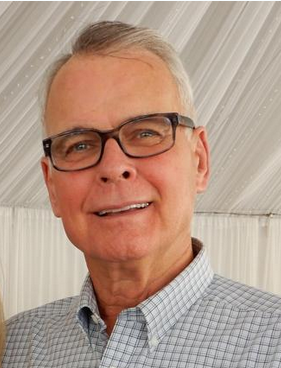 “The Water Education Foundation is mourning the loss of its Board President Mike Chrisman, the former California Natural Resources Secretary whose family ties to the Foundation go back to its founding in 1977. Mr. Chrisman, of Visalia, died from complications of cancer Tuesday, Oct. 11. He was 78. “We are devastated to learn about Mike’s passing,” said Jenn Bowles, the Foundation’s executive director. “He was a wonderfully supportive board president who cared deeply about our mission and was constantly offering to help. Among other things, he served as a mentor to up-and-coming professionals in our Water Leaders program.” ... ” Read more from the Water Education Foundation here: Water Education Foundation mourns loss of board president Mike Chrisman
“The Water Education Foundation is mourning the loss of its Board President Mike Chrisman, the former California Natural Resources Secretary whose family ties to the Foundation go back to its founding in 1977. Mr. Chrisman, of Visalia, died from complications of cancer Tuesday, Oct. 11. He was 78. “We are devastated to learn about Mike’s passing,” said Jenn Bowles, the Foundation’s executive director. “He was a wonderfully supportive board president who cared deeply about our mission and was constantly offering to help. Among other things, he served as a mentor to up-and-coming professionals in our Water Leaders program.” ... ” Read more from the Water Education Foundation here: Water Education Foundation mourns loss of board president Mike Chrisman
Melinda Booth to step down as SYRCL Executive Director at the 21st Wild & Scenic Film Festival in February
 “After nearly a dozen years with SYRCL, and five years at the helm of the South Yuba River Citizens League (SYRCL), Melinda Booth will step down as Executive Director following the 21st anniversary of the Wild & Scenic Film Festival in February 2023. Booth served in a number of leadership roles at SYRCL over the years. She was hired in 2011 as the Director of Development and Wild & Scenic Events, leading all fundraising efforts at SYRCL including the Wild & Scenic Film Festival. In 2015, she transitioned to Wild & Scenic Film Festival Director as the organization grew and the job she was hired into became two positions. In 2017 she was promoted to Executive Director where she has remained. “My time at SYRCL has been incredibly rewarding—this community is remarkable and I am honored to have contributed to SYRCL’s growth and successes over the years. This was a difficult decision, but one ultimately made to support what is best for my family, which has us leaving the area,” shared Melinda Booth, Executive Director. ... ” Read more from YubaNet here: Melinda Booth to step down as SYRCL Executive Director at the 21st Wild & Scenic Film Festival in February
“After nearly a dozen years with SYRCL, and five years at the helm of the South Yuba River Citizens League (SYRCL), Melinda Booth will step down as Executive Director following the 21st anniversary of the Wild & Scenic Film Festival in February 2023. Booth served in a number of leadership roles at SYRCL over the years. She was hired in 2011 as the Director of Development and Wild & Scenic Events, leading all fundraising efforts at SYRCL including the Wild & Scenic Film Festival. In 2015, she transitioned to Wild & Scenic Film Festival Director as the organization grew and the job she was hired into became two positions. In 2017 she was promoted to Executive Director where she has remained. “My time at SYRCL has been incredibly rewarding—this community is remarkable and I am honored to have contributed to SYRCL’s growth and successes over the years. This was a difficult decision, but one ultimately made to support what is best for my family, which has us leaving the area,” shared Melinda Booth, Executive Director. ... ” Read more from YubaNet here: Melinda Booth to step down as SYRCL Executive Director at the 21st Wild & Scenic Film Festival in February
Introducing the 2022–23 PPIC CalTrout Ecosystem Fellows
“In 2019, the PPIC CalTrout Ecosystem Fellowship was established to help turn science into action by shaping and improving water management in California. For the first few years of the fellowship, we worked with early- and mid-career experts in freshwater ecosystems to produce groundbreaking reports on environmental flows, advancing ecosystem restoration with smarter permitting, and improving reservoir operations to help freshwater ecosystems. This year, we’ve decided to try something different: We’re going to look at the human dimension of three river restoration projects. We’re bringing on three early- to mid-career journalists to report on community involvement in restoration efforts on a trio of critical but under-reported rivers: the Eel River, the San Joaquin River, and Trabuco Creek. ... ” Read more from the PPIC here: Introducing the 2022–23 PPIC CalTrout Ecosystem Fellows
This Native American tribe leader is bringing salmon restoration to the Metaverse
“Having been born into the salmon restoration movement, Pom, a Native American tribe leader in Northern California, is staking out how to use blockchain to revive the native species of Chinook salmon his community once relied on. To do so, Pom and his team created a video game called Salmon Journeys on Decentraland, where users can catch Chinook salmon to win an exclusive non-fungible token (NFT) by Sawalmen, a Web3 entity that represents Indigenous spiritual values and raises funds for restoration efforts and the landback movement. Pom’s goal with this game is to raise funds as well as awareness for actual salmon restoration efforts, he said. The game is part of an ongoing hackathon event, tied to CoinDesk’s I.D.E.A.S. conference. … ” Read more from Yahoo News here: This Native American tribe leader is bringing salmon restoration to the Metaverse
Podcasts …
WEST COAST WATER JUSTICE PODCAST: Protecting California’s water before it runs out
In this episode, we follow up with Clifford Lee, retired Deputy Attorney General with the California Department of Justice. We dive deeper into water policy and hear about critical changes needed to protect our most valuable resource: water! We are faced with a 27-year delay in the adoption of new scientific recommendations and species protections for the SF Bay Delta, the lifeblood of our state. While at the same time critical aquifers across the state are being over-pumped and going dry.We learn that California needs to catch up with other Western states on the regulation of groundwater extraction and quantifying river diversions. Clifford, a public servant of 40 years is sounding the alarm and urging us to educate ourselves about our water resources before they are gone. This episode is packed with the information we need now, so we can reform water policy in California for a sustainable future.
SCIENCE IN SHORT: The Hullabaloo About HABS
As California’s drought deepens, harmful algal blooms have been on the rise in the San Francisco Estuary. In this episode of science-in-short from Estuary News, Keith Bouma-Gregson, a biologist with the US Geological Survey, explains the science basics behind these sometimes toxic, sometimes deadly, events in our waterways, as well as the differences between Delta and Bay HABs and how climate change could increase the bloom period. Produced by Ariel Rubissow Okamoto and Callie Rhoades, with music by Peter Rubissow, and support from the Delta Stewardship Council.
EOS PODCAST: Not your childhood water cycle
It’s a sight most remember from childhood: a drawing showing the path of water from oceans to clouds to rivers. Long, lavish words like “evapotranspiration” and “precipitation” likely come to mind. The U.S. Geological Survey (USGS) water cycle diagram is still used by hundreds of thousands of students in the United States and worldwide. It’s also the basis for many, many spin-off diagrams. Today, the agency released a new diagram for the first time in more than 20 years, this time with humans as showrunners.
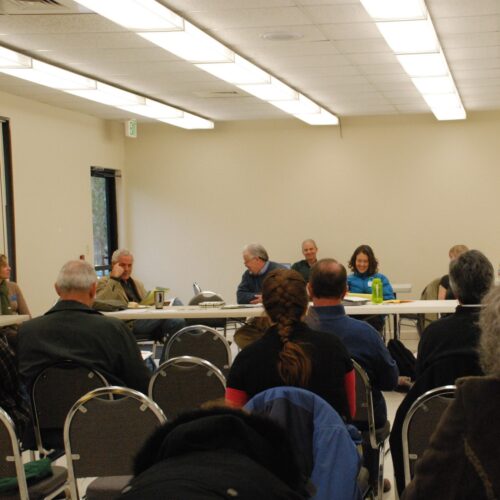 WATER IS A MANY SPLENDOR’ED THING PODCAST: Local Governance is Critically Important
WATER IS A MANY SPLENDOR’ED THING PODCAST: Local Governance is Critically Important
Imagine turning on the shower or the kitchen tap and not finding any water. After calling your neighbors, you find, they have no water. The neighborhood is experiencing what many have warned us about. Our aquifers are going dry. How do we manage our groundwater aquifers? Water is a Many Splendor ‘ed Thing brings you another water relationship that has a personally significant impact to your life. Produced by Steven Baker, Bringing People Together to Solve Water Problems, water@operationunite.co 530-205-6388
PLACE AND PURPOSE PODCAST w.Greg Sarris and Obi Kaufmann: October
Greg Sarris and Obi Kaufmann continue their live, video-podcast. This time broadcasting from Greg’s farm in Northern California.
VOICES OF THE VALLEY PODCAST: Jack Vessey on the pressing need to implement technology in desert agriculture
For Jack Vessey, President of Imperial Valley-based Vessey & Co., one fact of desert agriculture never changes: You have to do more with less. “We have to be proactive with trying things,” he said, noting that the pressures of labor, irrigation and crop protection lead him to always explore new technologies in his operations. The front of mind of these right now is, of course, water. “The future tells us that in the next five to 10 years we’re going to have to grow every seed with less water,” he said. “We’re looking out to see what the next great innovation is…at the end of the day, we have to have water to grow that crop.” From different irrigation techniques to different crops to soil amendments, Vessey is open to experimenting. “I don’t know about a silver bullet out there, but obviously our goal is to use less and less every year.”
In regional water news this weekend …
NORTH COAST
Suppression of invasive pikeminnow populations could help native Eel River salmonids
“Pikeminnow suppression has become a key priority for Eel River salmonid recovery. Fisheries researchers at Cal Poly Humboldt are exploring a novel approach to pikeminnow suppression, experimenting with modifying the sex chromosomes of hatchery-reared pikeminnow, initially in a controlled laboratory setting. CalTrout is thrilled to help fund the university’s graduate-student research that may eventually contribute to eliminating this invasive species from the Eel River. Since their introduction in 1979, pikeminnow have spread throughout the Eel River basin. Now pikeminnow compete with, prey on, and alter behavior of juvenile salmonids – all of which impacts salmon recovery. … To give these fish a fighting chance, researchers Dr. Andre Buchheister and Dr. Rafael Cuevas Uribe, from Cal Poly Humboldt Fisheries Department, have proposed the “Trojan Y Chromosome” (TYC) strategy. … ” Read more from Cal Trout here: Suppression of invasive pikeminnow populations could help native Eel River salmonids
A Field Note from the North Coast’s Cedar Creek
“I leave my home near Humboldt Bay in the cool pre-dawn darkness, heading south. Soon after leaving Eureka, I am driving through ancient redwoods along the South Fork Eel River. Today the South Fork Eel looks more like a large creek, but I know what this mighty river is capable of as I pass a high water marker remembering the 1964 flood. After passing State Parks and attractions for visitors touring the giant redwoods, I arrive at our team’s meeting spot and spend a few quiet moments waiting for the rest of our crew to arrive for today’s work. We are a mixed group of seasoned fish experts, experienced California Department of Fish and Wildlife (CDFW) staff, younger CDFW techs, and California Conservation Corps crew members here to finish the job we started a couple weeks ago: removing a 8-foot high concrete dam. … ” Read more from Cal Trout here: A Field Note from the North Coast’s Cedar Creek
MOUNTAIN COUNTIES
Salmon expedition teaches children about migration and the importance of a healthy ecosystem
“We are very proud and honored to partner with the Yuba Water Agency in several different projects across Marysville Joint Unified School District. We thank them for their ongoing generosity and support. The agency recently awarded more than $403,000 in water education grants to the South Yuba River Citizens League to continue its salmon expeditions program for 4th graders, in partnership with the Marysville Joint Unified School District.For the field trip, naturalists take the students on a day-long rafting adventure on the Yuba River. The excursion launches at Parks Bar, just off the Highway 20 bridge, and floats downriver for about 4.5 miles to Sycamore Ranch Park. The group stops many times throughout the day to teach students about various topics ... ” Read more from the Appeal Democrat here: Salmon expedition teaches children about migration and the importance of a healthy ecosystem
NAPA/SONOMA
Board of Supervisors adopts well drilling moratorium
“On Oct. 4, the Sonoma County Board of Supervisors approved a moratorium for drilling wells until April 4, 2023 in Sonoma County to allow county staff more time to develop recommendations for updating the county’s well ordinance. The board also directed Permit Sonoma, Sonoma County’s natural resources and permitting agency, to establish a Technical Advisory Committee to make recommendations for implementing Public Trust Review requirements. According to a press release published by Permit Sonoma, the county is updating its well ordinance in response to evolving California case law that requires local governments to protect the health of rivers and other public trust resources. To comply with a 2018 decision by the California Court of Appeal, the county will evaluate and require mitigation of impacts of well permits on public trust resources in navigable waterways, such as the Russian River, along with the habitat and wildlife they support, including the endangered Coho salmon. … ” Read more from the Kenwood Press here: Board of Supervisors adopts well drilling moratorium
BAY AREA
‘Swamp gas’ overtakes small Bay Area town, sparks hundreds of complaints
““Sugar Town” residents have been complaining about an acrid “rotten egg” smell that’s been clouding the air in the northwest Contra Costa County town of Crockett this month, government officials said. The county’s health services department said that hydrogen sulfide — also known as “sewer gas,” “swamp gas” and “stink damp” — has been emanating from the Crockett Wastewater Treatment Plant due to an unspecified operational issue. The plant, which processes sewage from the local community and sewage from the California and Hawaiian Sugar refinery, is owned by C&H and has since been investigated by local authorities. ... ” Read more from SF Gate here: ‘Swamp gas’ overtakes small Bay Area town, sparks hundreds of complaints
SEE ALSO: Angry Crockett residents confront officials over toxins in the air, from KTVU
Thirsty to know where her water comes from, CA Jewish activist hikes to its source
“On June 28, Nina Gordon-Kirsch picked up her backpack, opened the door to her Oakland, California, home and started walking. The 33-year-old activist and teacher was curious: When she turned on the faucet in her house, where did her water come from? To answer her question, she decided to trace the route of her water — on foot — from the faucet in her kitchen to the headwaters of the river that supplies her city’s drinking water. “As a young person in California, I never thought about my water, even though it’s the arid west,” said Gordon-Kirsch. “It always just came out of my tap. I never thought about where it was from.” … ” Read more from The Times of Israel here: Thirsty to know where her water comes from, CA Jewish activist hikes to its source
Residents hope new sewer lines will address smelly problem in San Andreas creek
“The San Andreas Sanitary District (SASD) has begun construction on a long-planned collections system project that will see the replacement of existing sewer lines from Treat Avenue through Pixley Avenue. Sections of this project stretch along San Andreas Creek, which runs through Turner Park, where multiple residents have voiced concerns about raw sewage leaking into the creek water.The collections system project aims to replace 3,791 feet of aging sewer lines from Treat Avenue through Pixley Avenue, with eight to 12-inch diameter piping to provide better flow and reduce maintenance costs for SASD customers. Twenty-one manholes will also be replaced, according to an official release from the SASD. … ” Read more from the Calaveras Enterprise here: Residents hope new sewer lines will address smelly problem in San Andreas creek
Of mice and marshes: Surveying salties to save them
“It’s five in the morning, and Don Edwards San Francisco Bay National Wildlife Refuge remains in the tight velvet grip of night. All is peaceful and quiet, despite the fact that the toll plaza of the Dumbarton Bridge is less than a quarter-mile away. By 5:15, car dome lights and slamming doors have transformed this lonely spot at the watery edge of Newark into a hub of activity. People are taking last sips of coffee, strapping headlamps to their foreheads, and swapping civilian footwear for rubber muck boots. The occasion that’s roused everyone from bed more than an hour before sunrise? The first survey of the salt marsh harvest mouse conducted across the rodent’s entire San Francisco Bay-centered range. ... ” Continue reading at Estuary News here: Of mice and marshes: Surveying salties to save them
Drought strains stormwater monitoring endeavors
“When it rains, it pours. This old saw passes for an apt description of the new precipitation regime that climate change has wrought for the Bay Area: larger winter storms, but fewer of them. The implications of this shift for ecosystems, infrastucture, and water storage are widespread, and often highly visible. But behind the scenes, it is also complicating efforts to monitor pollution inputs to the San Francisco Bay and other local water bodies from stormwater runoff. The Regional Monitoring Program for Water Quality in San Francisco Bay (RMP) has been collecting data in Bay water, sediment, and biota since 1993. RMP monitoring of stormwater flows after rain events, which began in 2006, has shown that runoff is a major pathway to the Bay for “legacy” contaminants like PCBs and mercury, as well as contaminants of emerging concern like PFAS and chemicals used in automobile tires. … ” Read more from Estuary News here: Drought strains stormwater monitoring endeavors
CENTRAL COAST
Resurrecting the Carmel River floodplain
“The Carmel River of the late 20th century was a tale of California water extremes writ small. In 1998 it flooded homes again, but in most years, the river was largely reduced to a trickle as it was siphoned off to water the blooming tourist mecca of the Monterey Peninsula. Endangered steelhead trout, members of the southernmost surviving population, would often find their attempts to swim upriver and spawn thwarted by strandings in low water before they could even reach the impassable dams upstream. The national advocacy group American Rivers even included the Carmel on its infamous “Most Endangered Rivers” list in 1999. But in the last decade, the river has staged a surging comeback, with a high-profile dam removal in 2015 presaging a new wave of restoration about to break ground. … ” Read more from Estuary News here: Resurrecting the Carmel River floodplain
SAN JOAQUIN VALLEY
East Turlock Groundwater Sustainability Agency needs your input on groundwater fees
“In 2014, California became one of the last states to formally regulate groundwater at the state level when the Sustainable Groundwater Management Act (SGMA) was signed into law. Over the last 8 years, boundaries have been drawn, Groundwater Sustainability Agencies (GSAs) formed, and Plans submitted to Department of Water Resources. The hard work bringing groundwater recharge and use into a sustainable balance within 20 years is now beginning. The ETSGSA would like to invite all residents to a Groundwater Accounting Options and Extraction Fees Workshop on Tuesday, October 18th at 9:30am. This workshop will be held at Cortez Hall, 12937 N. Cortez Ave., Turlock. … ” Read more from the Turlock Journal here: East Turlock Groundwater Sustainability Agency needs your input on groundwater fees
Hurtado presents $100 million ceremonial check during Friant-Kern ceremony
“The progress on the much needed repairs to the Friant-Kern Canal could be viewed in the background as local and state officials gathered at the canal on Friday to recognize the progress being made on the project. The ceremony was held by State Senator Melissa Hurtado who presented a ceremonial $100 million check during the event at Avenue 96 and Road 208. It was the same place where the groundbreaking for the project was held on January 25 of this year. The project has been made possible in part due to funding Hurtado has helped secure in the state budget. .. ” Read more from the Porterville Recorder here: Hurtado presents $100 million ceremonial check during Friant-Kern ceremony
SOUTHERN CALIFORNIA
Santa Clarita commentary: Our water situation vs. L.A.
 “Recently a friend asked me why some areas are out of water and some are not. The answer is twofold: location and politics. This is why Santa Clarita is on three-day-a-week watering for homeowners and greater Los Angeles is on one day a week. This is why some communities have to truck in water during dry years and why some areas don’t. Location matters in the water world and will matter even more in the future. If your area has good groundwater supply, like Santa Clarita, that makes a big difference. Santa Clarita’s groundwater pumping is sustainable, and we don’t hesitate to install water treatment when needed. Some areas have ignored groundwater pollution as “too hard to address.” Much of the Central Valley has depleted groundwater. Coastal areas have pumped so much groundwater that seawater has moved inland into their water table, ruining it. … ” Read more from the Santa Clarita Valley Signal here: Santa Clarita commentary: Our water situation vs. L.A.
“Recently a friend asked me why some areas are out of water and some are not. The answer is twofold: location and politics. This is why Santa Clarita is on three-day-a-week watering for homeowners and greater Los Angeles is on one day a week. This is why some communities have to truck in water during dry years and why some areas don’t. Location matters in the water world and will matter even more in the future. If your area has good groundwater supply, like Santa Clarita, that makes a big difference. Santa Clarita’s groundwater pumping is sustainable, and we don’t hesitate to install water treatment when needed. Some areas have ignored groundwater pollution as “too hard to address.” Much of the Central Valley has depleted groundwater. Coastal areas have pumped so much groundwater that seawater has moved inland into their water table, ruining it. … ” Read more from the Santa Clarita Valley Signal here: Santa Clarita commentary: Our water situation vs. L.A.
Rock sea wall repairs approved for Strands Beach in Dana Point
“The county has gotten approval from the California Coastal Commission – after being denied in the past – to reinforce a rock sea wall at Strands Beach where an ancient landslide threatens bluff-top homes. An estimated 1,000 tons of boulders will be used to fill the base of the cliffside in a project approved Thursday, Oct. 13, adding to the already-existing 5,000 tons of large rocks that form the quarter-mile-long revetment. The rock wall, which has been in place since the 1970s, secures the bluff below 60 or so homes in the Niguel Shores neighborhood. The Coastal Commission denied the county’s requests to secure the site in 2020, and prior to that in 2012, with members voicing concerns the plan would result in a loss of public beach to benefit homeowners at taxpayer expense and the proposal lacked enough mitigation measures to make up for impacts to the public stretch of coastline. … ” Read more from the OC Register here: Rock sea wall repairs approved for Strands Beach in Dana Point
Coastal Commission approves plan to bury contaminated sediment in Newport Harbor
“The California Coastal Commission on Friday approved plans to bury contaminated sediment in an underwater pit at the bottom of Newport Harbor — a plan that’s drawn vocal opposition from some environmentalists and residents. The vote moves the city of Newport Beach and U.S. Army Corps of Engineers closer to starting work on the $12 million project by the end of the year. Commissioners, who voted 8-1 in favor of a permit for the project, praised Newport Beach staff for developing a “local solution to a locally sourced problem.” And they said they trusted commission staff, who called the project the “least damaging feasible alternative” for getting rid of contaminated sediment in the area. … ” Read more from the OC Register here: Coastal Commission approves plan to bury contaminated sediment in Newport Harbor
IMPERIAL/COACHELLA VALLEYS
Downpour results in flooding, power outages
“A downpour that included hail and strong gusts of wind inundated streets, toppled utility poles and prompted power outages across the central part of the Valley about midday Saturday, Oct. 15. The storm prompted a flash flood warning to be in effect until 5:15 p.m., Saturday, as well, the National Weather Service (NWS) reported. Rainfall in El Centro totaled about 0.02 of an inch, Jason Sawtelle, an NWS meteorologist, said in a phone interview. At Naval Air Facility El Centro, a rain gauge recorded about 0.05 of an inch, Sawtelle said. Wind gusts ranged between 30 to 40 miles per hour, he said. … ” Read more from the Holtville Tribune here: Downpour results in flooding, power outages
Along the Colorado River …
How more Colorado River water cuts could affect farming and the economy
 “California is in its driest year to date. It can be seen across the state, but one area hit the hardest is the Colorado River. Now, the federal government is proposing more solutions to help the dwindling river and its directed towards the backbone of our economy: farming. “I understand that we’re in a water crisis,” President of Aziz Farms in Thermal, Mark Tadros, said. “But also, we need to be looking at other ways to save water than just saying, stop growing food that we need, which is really what it boils down to. We need this food and we need to keep growing.” … ” Read more from NBC Palm Springs here: How more Colorado River water cuts could affect farming and the economy
“California is in its driest year to date. It can be seen across the state, but one area hit the hardest is the Colorado River. Now, the federal government is proposing more solutions to help the dwindling river and its directed towards the backbone of our economy: farming. “I understand that we’re in a water crisis,” President of Aziz Farms in Thermal, Mark Tadros, said. “But also, we need to be looking at other ways to save water than just saying, stop growing food that we need, which is really what it boils down to. We need this food and we need to keep growing.” … ” Read more from NBC Palm Springs here: How more Colorado River water cuts could affect farming and the economy
Pipeline’s end brings relief to eastern Nevada — for now
“For more than 30 years, Southern Nevada water officials had a simple plan to fuel the valley’s explosive growth: pump groundwater from rural valleys in eastern Nevada to Las Vegas. The water would make a 300-mile trip from arid basins in rural Nevada through a pipeline to Las Vegas. But for three decades, a group of odd bedfellows that included rural ranchers, environmentalists, Native American tribes and even the Church of Jesus Christ of Latter-day Saints fought the project at every turn — before a judge finally dealt it a fatal blow in March 2020. To its opponents, the pipeline was a looming threat that would have devastated ranching communities, high desert ecosystems, Native American sacred sites and more. But for Southern Nevada, the pipeline was a key backup plan should Lake Mead ever start to dry up — something once talked about as only a remote possibility decades down the line, but which now stands as a reality staring the Southwest square in the face. Conditions along the Colorado River have deteriorated far more rapidly than predicted, with eroding hydrology, climate change and chronic overuse all taking a toll during a two-decades-long drought. … ” Read more from the Las Vegas Review Journal here: Pipeline’s end brings relief to eastern Nevada — for now
A shock of cold water could help control exotic fish in Grand Canyon
“The Grand Canyon is a haven for native fish. But that’s now threatened by smallmouth bass, an exotic fish that eats native species and has recently escaped through Glen Canyon Dam. Scientists say a shock of cold water released through the dam might help keep their numbers down. KNAU’s Melissa Sevigny spoke with fish biologist Drew Eppehimer about the tradeoffs involved. … ” Read more from KNAU here: A shock of cold water could help control exotic fish in Grand Canyon
In national water news this weekend …
More than 80 percent of the U.S. is facing troubling drought conditions
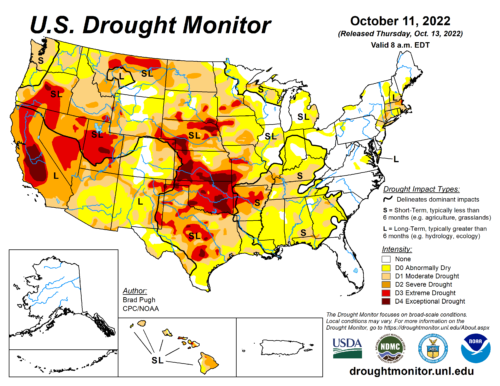 “The most recent update to the U.S. Drought Monitor revealed a startling figure: Nearly 82 percent of the country is facing at least abnormally dry conditions — the highest percentage since the drought monitor launched in 2000. Severe to exceptional drought conditions remain common in the West, which has been battling its driest period in the past 1,200 years. But the drought is now far more widespread, with unusual dryness continuing in parts of the Northeast and expanding extreme drought conditions in the Midwest. … ” Read more from the Washington Post here: More than 80 percent of the U.S. is facing troubling drought conditions
“The most recent update to the U.S. Drought Monitor revealed a startling figure: Nearly 82 percent of the country is facing at least abnormally dry conditions — the highest percentage since the drought monitor launched in 2000. Severe to exceptional drought conditions remain common in the West, which has been battling its driest period in the past 1,200 years. But the drought is now far more widespread, with unusual dryness continuing in parts of the Northeast and expanding extreme drought conditions in the Midwest. … ” Read more from the Washington Post here: More than 80 percent of the U.S. is facing troubling drought conditions
The cost to capture carbon? More water and electricity
“A carbon capture proposal for a central Louisiana power plant has been titled “Project Diamond Vault” by its owner, Louisiana utility Cleco. The utility says the project will have “precious value” to the company, customers and state. Yet less than six months after announcing the project to capture carbon from the plant’s emissions and store them underground near the plant, Cleco revealed in a recent filing to its state regulator the $900m carbon capture retrofit could reduce electricity produced for its customers by about 30%. Cleco maintains it hasn’t committed to this path. But, if it decides to produce additional power necessary to run the carbon capture process, it could increase the plant’s water use by about 55%, according to studies of similar power plants. The Louisiana project is not an outlier. Operating enough carbon capture to keep the climate crisis in check would double humanity’s water use, according to University of California, Berkeley researchers. … ” Read more from the Guardian here: The cost to capture carbon? More water and electricity
And lastly …
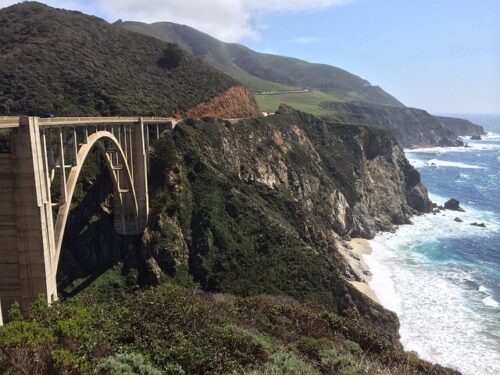 Highway 1 Road Trip: Six itineraries along California’s iconic coast
Highway 1 Road Trip: Six itineraries along California’s iconic coast
“California’s coastal highway is a national treasure. This wondrous, 1,000-mile driving route weaves through long stretches of rugged, natural scenery the likes of which you won’t find anywhere else on Earth, punctuated by historic towns and, of course, the state’s cultural capitals. This is the ultimate guide to the unrivaled experience that is Highway 1. We have parsed the route into 6 unique regions, each with its own character and flavor, and spotlighted 153 must-see stops, landmarks and towns along the way. Here you’ll find a mix of the coast’s greatest hits, boutique stopovers and under-the-radar experiences to help you plan your perfect coastal getaway. … ” Read more from the San Francisco Chronicle here: Highway 1 Road Trip: Six itineraries along California’s iconic coast
Return to top

